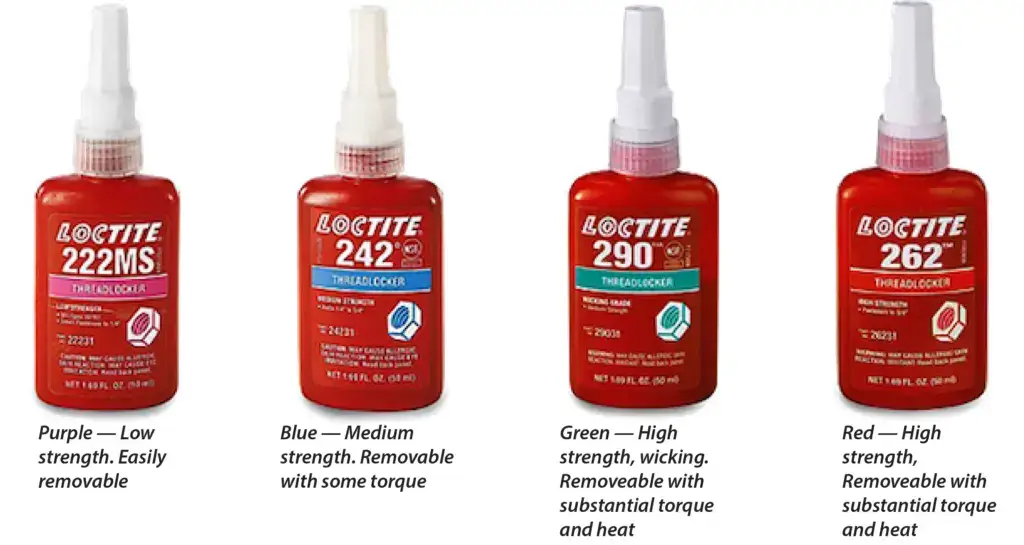When to use threadlocker and which type to use
Understanding Threadlocker: When to Use It and Choosing the Right Type
Threadlocker is a versatile and essential tool in the world of automotive, industrial, and DIY maintenance. It’s an adhesive designed to lock and seal threaded fasteners, preventing them from loosening due to vibration, thermal expansion, or other mechanical stresses. However, not all threadlockers are created equal, and using the wrong type can lead to complications. This article will guide you through when to use Threadlocker, the available types, and how to choose the right one for your application.
What is Threadlocker?
Threadlocker is an anaerobic adhesive, meaning it cures in the absence of air and in the presence of metal ions. Once applied to a threaded fastener, such as a bolt or screw, it creates a secure bond that prevents the fastener from loosening under stress. Threadlockers are available in various strengths and formulations, each designed for specific applications and materials.
When to Use Threadlocker
Threadlocker is used when it’s critical to keep fasteners securely in place, but it also allows for easy disassembly when needed. Here are some common scenarios where Threadlocker is beneficial:
Vibration-Prone Environments: One of the primary uses of threadlocker is in environments subject to constant vibration, such as automotive engines, motorcycles, bicycles, and industrial machinery. Vibration can cause fasteners to gradually loosen over time, leading to mechanical failures. Applying threadlocker in these situations ensures that bolts and screws remain tight, maintaining the integrity of the assembly.
Thermal Cycling: In applications where temperature fluctuates significantly, such as in engines or heating systems, thermal expansion and contraction can cause fasteners to loosen. Threadlocker helps maintain a consistent hold, even under these conditions, by filling gaps and creating a strong bond that resists thermal cycling effects.
Preventing Leaks: Threadlocker also serves as a sealant, preventing leaks in fluid systems such as fuel lines, hydraulic systems, and water pumps. By sealing the threads, it blocks the pathways that fluids might use to escape, ensuring the system remains leak-free.
Critical Fasteners: In any application where a loose fastener could lead to serious damage or safety issues, threadlocker is a must. This includes components like brake systems, suspension parts, and structural bolts in vehicles and machinery. Threadlocker ensures that these critical fasteners stay secure, reducing the risk of failure.
Corrosion Prevention: Threadlocker also provides a level of protection against corrosion. By sealing the threads, it prevents moisture, chemicals, and other corrosive elements from penetrating and degrading the metal, which is particularly important in harsh environments or where metals are exposed to corrosive substances.
Where you’ll find Threadlocker used in automotive applications
• Brakes — You find it on caliper bracket bolts and caliper slide bolts
• Struts — Some carmakers use it on the large bolts that secure the strut to the steering knuckle and sometimes on the bolts that secure the strut mount to the strut tower.
• Suspension — You’ll sometimes find it on ball joint studs, lateral arm bolts, and unitized wheel bearings
How to use Threadlocker
If the bolt originally had Threadlocker, it must be removed using a wire brush. Then, apply fresh fluid to the threads and install it to the specified torque. If you’re installing a new bolt, apply it to the threads that will be in contact with the nut or threaded portion of the component.
What type of threadlocker to use
Purple — Low-strength fluid locks the fastener but allows for easy disassembly.
Blue— Medium strength locks the fastener but allows it to come apart using a fair amount of torque.
Green— This Is a high-strength wicking formula. It is best for pre-assembled fasteners that need extra protection against loosening. Apply it, and it wicks down the threads. It requires heat and high torque to disassemble.
Red— This Is a high-strength permanent adhesive. It can’t be removed using torque alone; you must use heat as well. Use it for fasteners that you don’t expect to remove.
Permatex High Strength Removable ORANGE GEL
Permatex High Strength Removable Threadlocker
ORANGE GEL is a hybrid formula that combines the strength of Threadlocker RED with the removability of Threadlocker BLUE. Threadlocker ORANGE GEL is ideal for modern-day engine bays with many lightweight components and high vibration applications. Unlike traditional Threadlocker RED, Threadlocker ORANGE GEL can be removed with hand tools when extra force is applied.
How Threadlocker fluids cure
For more information on threadlocker strength and cure times, see this chart
©, 2021 Rick Muscoplat
Posted on by Rick Muscoplat

